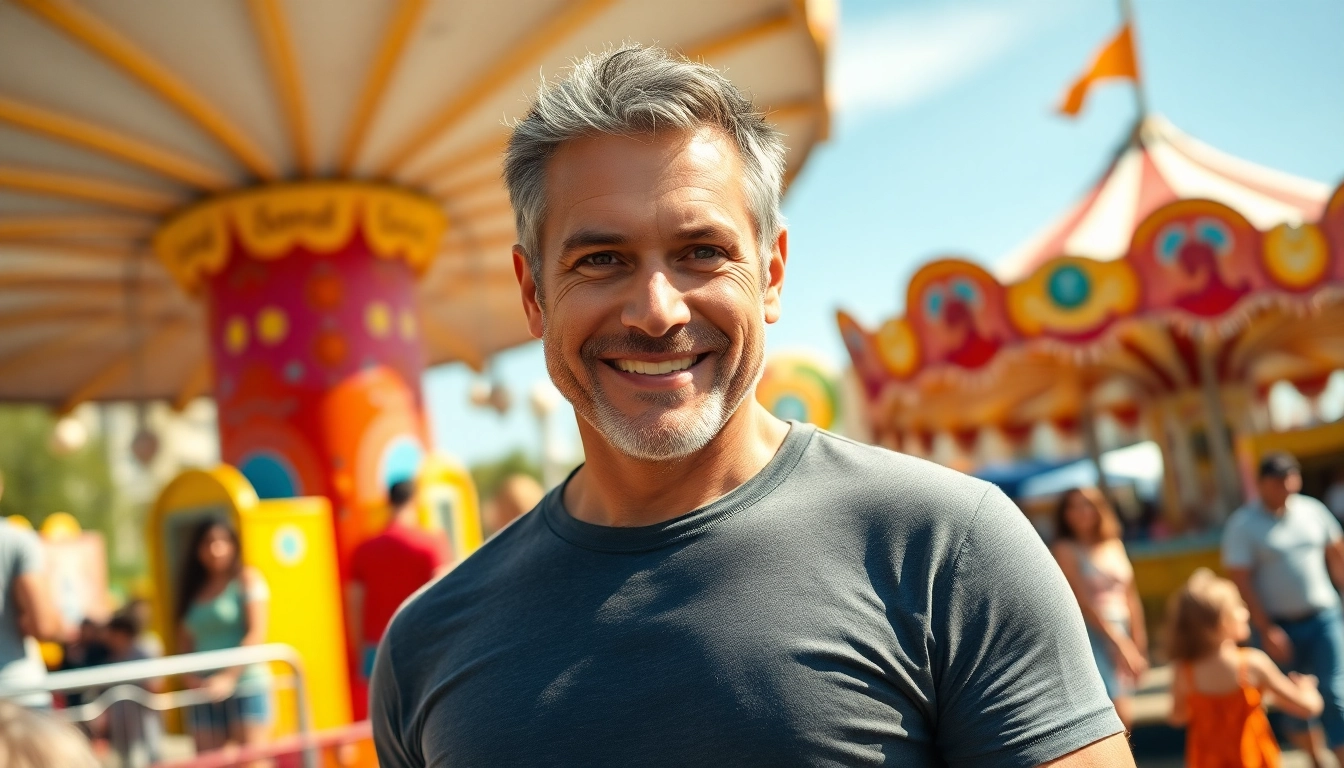What is a DILF? Definition and Origins
The term dilf is a colloquial acronym that stands for “Dad/Daddy I’d Like to F*.” It is used to describe an older, mature man who is considered sexually attractive and appealing. Interestingly, the label does not necessarily imply that the man is a father; rather, it emphasizes a certain combination of age, maturity, and attractiveness that resonates with many people. The origin of the term is relatively recent, gaining popularity shortly after the rise of the similar and widely recognized term MILF, which stands for “Mother I’d Like to F*.” While MILF tends to focus on maternal attractiveness, DILF shifts the focus toward older men who exude a charismatic, confident, and often rugged appeal.
The term was initially coined in online communities and pop culture, often used humorously or as a compliment. Its slang nature allows for playful teasing, admiration, or admiration tinged with humor. Over time, the definition has broadened, and the term has become embedded in various facets of media, internet culture, and everyday conversations. The concept of a DILF challenges traditional notions of attractiveness, emphasizing that age and maturity can be equally or more appealing than youth.
The Cultural Evolution of the DILF Term
The evolution of the dilf term reflects societal shifts in attitudes toward masculinity, attractiveness, and sexuality. Initially a niche internet slang, the term gained mainstream recognition through pop culture, social media, and entertainment. Its rise paralleled an increased appreciation for diverse representations of masculinity that celebrate maturity, confidence, and experience.
In the early days, DILF was primarily used in online forums and meme culture, often as a humorous or teasing label. As the term gained popularity, it started appearing in movies, TV shows, and online content, solidifying its place in contemporary vernacular. The cultural acceptance of older, attractive men as desirable figures in media has contributed significantly to this evolution. It also reflects a broader societal trend toward embracing aging as a positive attribute rather than something to be hidden or stigmatized.
Today, the dilf phenomenon is intertwined with discussions around masculinity, attractiveness, and sexuality. It illustrates shifting perceptions that value confidence, charisma, and maturity, which often resonate more deeply with audiences than traditional notions of youthful beauty.
DILFs in Popular Culture: Films, TV, and Video Games
Daddy Halsin in Baldur’s Gate
One of the most notable recent examples of the DILF archetype in popular culture is the character Daddy Halsin from the popular video game Baldur’s Gate III. Halsin is a druid and a leader, known for his protective nature, strength, and commanding presence. Fans of the game have affectionately dubbed him “Daddy Halsin,” appreciating his mature demeanor, rugged appearance, and the aura of authority he exudes. His character embodies many traits commonly associated with the DILF stereotype—maturity, confidence, and attractiveness—making him a fan favorite among gamers and online communities.
Halsin’s popularity highlights how video games are increasingly embracing diverse representations of attractiveness, including the appeal of older, powerful characters. His persona combines physical strength with a nurturing, protective attitude, aligning well with the traditional DILF image. The character’s rise in prominence also reflects how internet culture enthusiastically adopts and amplifies such archetypes, turning gaming characters into modern icons of attractiveness.
Fred Andrews in Riverdale
On television, one of the most recognizable DILF figures is Fred Andrews, portrayed by Luke Perry in the series Riverdale. Starting from its premiere in 2017, Fred Andrew’s character quickly became a fan favorite, embodying the qualities of a classic, mature, and attractive father figure. His role as a caring, strong, and dependable dad resonated with viewers, many of whom consider him a quintessential DILF.
Fred Andrews’ character has contributed to broader cultural conversations about masculinity and attractiveness in older men. His portrayal emphasizes a combination of rugged masculinity, emotional vulnerability, and paternal warmth—traits that have helped redefine what it means to be a desirable man in modern media. His popularity also demonstrates how the appeal of older male characters continues to grow, especially when they are portrayed with depth and authenticity.
Rob’s Father in American Pie Presents
The American Pie franchise, particularly the American Pie Presents: The Book of Love (2009), introduced a humorous yet notable DILF character—Rob’s father. The film, which stems from the franchise that popularized the term MILF, features a character that embodies the DILF archetype—older, attractive, and sexually appealing. His portrayal plays into comedic scenarios but also subtly celebrates the allure of mature masculinity.
This portrayal exemplifies how the concept of the DILF has permeated comedy and adult entertainment, often used as a humorous device but also as a genuine compliment. It underscores the idea that attractiveness is not limited by age and that older men can be equally desirable and sexy as their younger counterparts.
Internet and Social Media Trends
DILFs of Disneyland Instagram Account
One of the most fascinating manifestations of the DILF phenomenon in contemporary internet culture is the DILFs of Disneyland Instagram account. With over 300,000 followers, this account curates photos of DILFs spending quality family time at Disneyland, capturing candid moments of older men enjoying the theme park with their families.
This trend exemplifies how the term has transcended online slang to become a celebration of real-life individuals. The account showcases diverse men who fit the DILF stereotype—confident, attractive, and often with a playful or charming demeanor—highlighting how attractiveness and appeal are appreciated across different age groups and settings. It also challenges stereotypes that associate attractiveness solely with youth, emphasizing that older men can be just as charismatic and desirable.
Reddit Communities and Online Discussions
Online platforms like Reddit have cultivated dedicated communities such as r/DILFs, which boasts nearly 100,000 members. This NSFW subreddit serves as a space for sharing images, videos, and discussions centered around the DILF archetype. Members often post and celebrate photos of attractive older men, discuss their favorite DILFs from pop culture, and explore the appeal of mature masculinity.
This community reflects how internet culture embraces and normalizes the appreciation for older, confident men. It also demonstrates the blending of humor, admiration, and sexuality, creating a space where the term is used both as a compliment and an expression of aesthetic appreciation. Such online communities are instrumental in shaping and spreading the DILF phenomenon as part of modern internet culture.
The Appeal and Stereotypes of DILFs
The attraction to DILFs is multifaceted, rooted in both physical and psychological factors. Physically, many find the rugged, mature appearance appealing—think of strong jawlines, graying hair, or a confident demeanor that signals experience and self-assurance. Psychologically, the appeal often involves perceptions of stability, confidence, and life experience—qualities that are associated with maturity and emotional depth.
Stereotypes associated with DILFs often include being protective, responsible, and capable—traits that evoke feelings of security and admiration. They are frequently depicted as the quintessential “bad boy” turned dependable adult, or as the nurturing father figure with a charismatic edge. These stereotypes play into the allure of the DILF archetype, blending attractiveness with personality traits that suggest reliability and strength.
The Role of Humor and Compliment in DILF Usage
The use of dilf often carries a humorous undertone, serving as a playful compliment rather than a serious designation. This duality allows people to express admiration or attraction while also engaging in light-hearted banter. The term’s origins in internet slang and meme culture have cemented its status as a humorous, sometimes tongue-in-cheek, way to acknowledge attractiveness in older men.
In many contexts, calling someone a DILF is a form of flattery, emphasizing their sex appeal regardless of age. It also reflects broader societal attitudes that increasingly celebrate masculinity and attractiveness in men of all ages. The humor associated with the term helps to normalize the appreciation of older men as desirable, challenging stereotypes that aging diminishes attractiveness.
Future Trends and the Impact of Pop Culture on DILF Perceptions / Understanding the DILF Phenomenon: From Pop Culture to Internet Trends
The DILF phenomenon is poised to continue evolving as pop culture and internet trends influence perceptions of masculinity and attractiveness. The ongoing representation of older, confident men in movies, television, and video games reinforces the idea that desirability is not confined to youth. Characters like Daddy Halsin or Fred Andrews serve as modern icons, inspiring a broader acceptance of aging masculinity.
Moreover, social media platforms and online communities will likely play an increasingly significant role in shaping and normalizing the DILF archetype. As more real-life individuals share their stories and images, the stereotype expands to include diverse looks, backgrounds, and personalities, emphasizing that attractiveness is subjective and multifaceted.
In the future, the dilf concept may become even more mainstream, moving beyond internet slang and pop culture references to become a celebrated aspect of human diversity and attractiveness. This shift will contribute to a more inclusive understanding of masculinity, aging, and sexuality—highlighting that confidence, charisma, and appeal are timeless qualities that grow richer with age.
Ultimately, the DILF phenomenon exemplifies how cultural narratives evolve, embracing a broader spectrum of beauty standards and challenging traditional stereotypes. It underscores the importance of recognizing attractiveness as a dynamic, age-inclusive concept that reflects a more authentic and diverse view of human sexuality and appeal.

